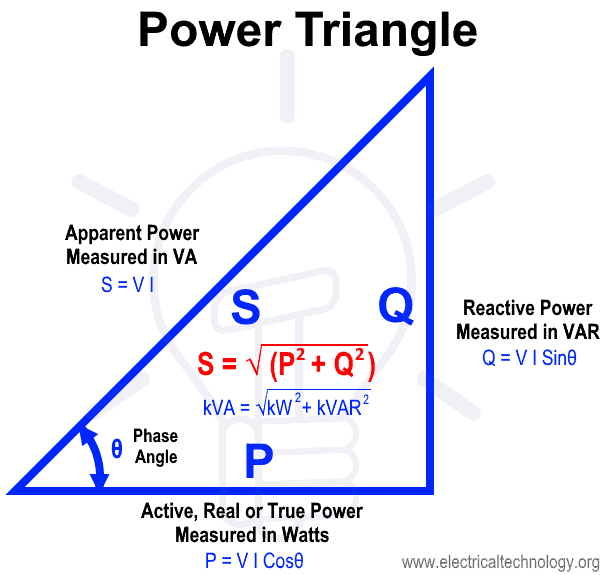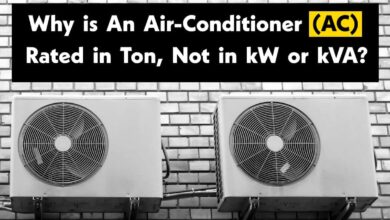Difference Between Active and Reactive Power – kW vs KVA
Main Difference Between Active and Reactive Power – W vs VA
The main difference between active and reactive power is that Active Power is actual or real power which is used in the circuit while Reactive power bounce back and forth between load and source which is theoretically useless.
The following power triangle shows the relation between Active, Reactive and Apparent Power. These all powers only induced in AC circuits when current is leading or lagging behind the voltage i.e. there is a phase difference (phase angle (Φ) between voltage and current.
- Related Post: Difference between Active and Passive Components
What is Active Power?
The Power which is really utilized and consumed for useful works in AC or DC circuit is known as Active Power. It is also called True Power, Real Power, Useful Power or Watt-full Power. It is denoted by “P” and measured in Watts, kW or MW. The average value of active power can be calculated by the following formulas.
Formulas for Active Power
- P = V x I … (DC circuits)
- P = V x I x Cosθ … ( Single phase AC Circuits)
- P = √3 x VL x IL x Cosθ … (Three Phase AC Circuits)
- kW = √ (kVA2 – kVAR2)
Related Post: Difference between Analog and Digital Multimeter
What is Reactive Power
The power which moves and back (bounces back and forth) between source and load in the circuit is known as Reactive Power. It is also called, Useless Power or Watt-less Power. Reactive Power is denoted by “Q” and measured in VAR (Volt Ampere Reactive), kVAR or MVARs.
Reactive Power is useful too i.e. it helps to produce magnetic and electric field and stores in the circuits and discharge by transformers, solenoid, and induction motors etc.
Formulas for Reactive Power
- Q = V x I x Sinθ
- VAR = √ (VA2 – P2)
- kVAR = √ (kVA2 – kW2)
- Reactive Power = √ (Apparent Power2 – True power2)
Related Post: Difference Between Capacitor and Supercapacitor
Comparison Between Active Power and Reactive Power.
The following table shows the main differences between Active and Reactive Powers.
| Characteristics | Active Power | Reactive Power |
| Definition | The True or Real or Actual Power dissipated in the circuit is known as Active Power which is actually utilized or consumed. (Also known as useful or watt-full power). | A Power which continuously bounces back and forth between source and load is known as Reactive Power. (Also known as useless or watt-less Power). |
| Represented by | P | Q |
| Units | Watts, kW, MW | VAr, kVAr, MVAr |
| Formulas |
|
|
| Measuring Instrument | Watt meter | VAr meter |
| Role in DC Circuits | Active Power is equal to the Reactive Power i.e. there is no VAr in DC Circuits. Only Active Power exists. | There is no Reactive Power in DC circuits due to the zero phase angle (Φ) between current and voltage. |
| Role in AC Circuits | Active power is important to produce heat and utilize the electric and magnetic field generated by Reactive Power. | Reactive Power plays an important role in AC circuits to produce magnetic and electric fields. |
| Behavior in Pure Resistive Circuit | All circuit Power is dissipated by the resistors which is Active Power. | No Reactive Power in pure resistive circuit. |
| Behavior in Pure Capacitive Circuit | Active Power is Zero (0) i.e. all power is alternately absorbed from and returned to the AC source continuously. | Leading Vars. In pure capacitive load circuit, Voltage and current are 90° out of phase with each other (current is leading by 90° degree from voltage ( in other words, Voltage is lagging 90° Degree from current). I.e. Leading Reactive Power. |
| Behavior in Pure Inductive Circuit | Active Power is Zero (0) P = V I Cos θ When: Cos ( 90°) = 0 Power P = V I (0) = 0 Then Total Active Power is = 0 Watts. |
Lagging Vars. In pure inductive or reactive load circuit, Voltage and current are 90° out of phase with each other (current is lagging by 90° degree from voltage (in other words, Voltage is leading 90° Degree from current). I.e. Leading Reactive Power. |
| Applications | Active Power is used to produce heat, light, torque etc. in electrical appliances and machines. | Reactive Power is useful too, which is used to measure the power factor and generate magnetic flux, electric flux, electric and magnetic field in motors, transformers, ballasts and induction heating equipment etc. |
Related Posts:
- What is Electrical Power? Types of Electric Power and their Units
- Why Do Electronic Circuits Use DC Current instead of AC?
- Difference Between a Battery and a Capacitor
- Difference Between Relay and Circuit Breaker
- Main Difference between Fuse and Circuit Breaker
- Difference between Analog and Digital Multimeter
- Difference Between EMF and MMF
- Difference Between Voltage and EMF?
- Difference Between Current and Voltage








It is not small concept, Play wide roll during EHV transmission.
Check this… Is Reactive Power Useful? Importance of Reactive Power
about electronic rquipment
Thank you for this info. I’ve just found these articles and I must say they provide a lot of clarity.